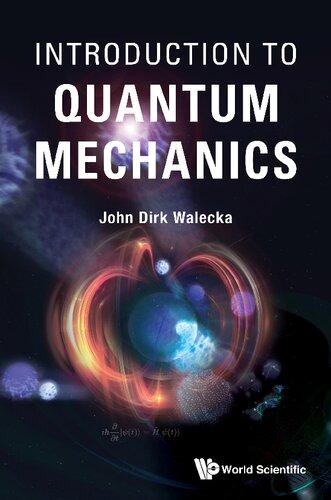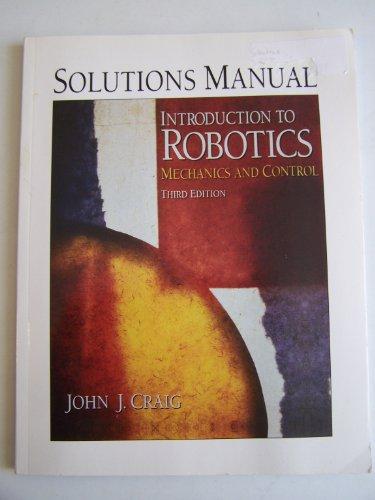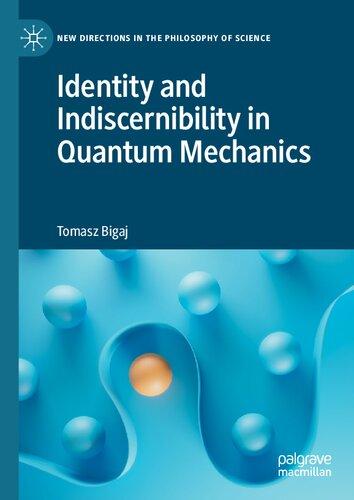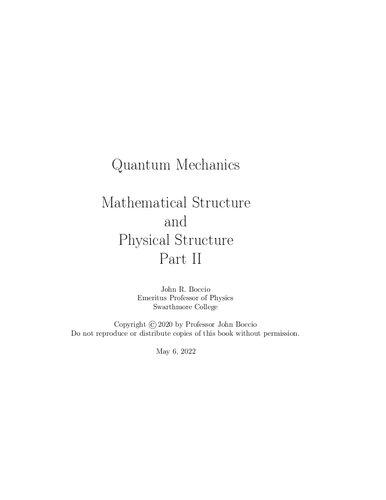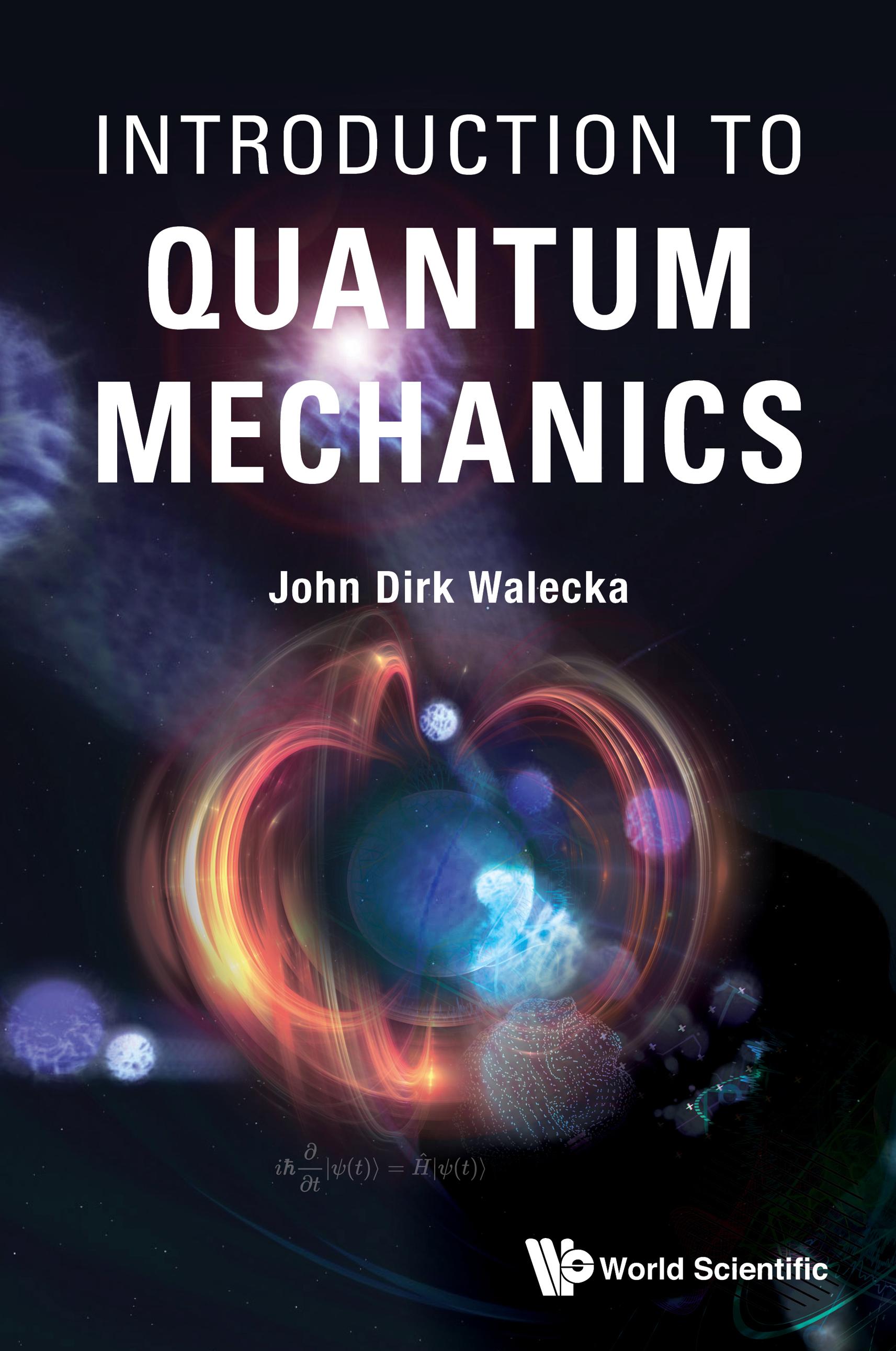Introduction to Quantum Mechanics John Dirk Walecka Visit to download the full and correct content document: https://ebookmass.com/product/introduction-to-quantum-mechanics-john-dirk-walecka /
More products digital (pdf, epub, mobi) instant download maybe you interests ...
ELECTRON SCATTERING FOR NUCLEAR AND NUCLEON STRUCTURE John Dirk Walecka
https://ebookmass.com/product/electron-scattering-for-nuclearand-nucleon-structure-john-dirk-walecka/
Solutions Manual to Introduction to Robotics Mechanics and Control Third Edition John J. Craig
https://ebookmass.com/product/solutions-manual-to-introductionto-robotics-mechanics-and-control-third-edition-john-j-craig/
Consciousness and Quantum Mechanics 1st Edition Shan Gao (Editor)
https://ebookmass.com/product/consciousness-and-quantummechanics-1st-edition-shan-gao-editor/
An Introduction to quantum optics and quantum fluctuations First Edition. Edition Milonni
https://ebookmass.com/product/an-introduction-to-quantum-opticsand-quantum-fluctuations-first-edition-edition-milonni/
Introduction to Fracture Mechanics Robert O. Ritchie https://ebookmass.com/product/introduction-to-fracture-mechanicsrobert-o-ritchie/
Quantum Mechanics 3rd Edition Nouredine Zettili https://ebookmass.com/product/quantum-mechanics-3rd-editionnouredine-zettili/
Introduction to Quantum Field Theory with Applications to Quantum Gravity 1st Edition Iosif L. Buchbinder https://ebookmass.com/product/introduction-to-quantum-fieldtheory-with-applications-to-quantum-gravity-1st-edition-iosif-lbuchbinder/
Identity and Indiscernibility in Quantum Mechanics Tomasz Bigaj
https://ebookmass.com/product/identity-and-indiscernibility-inquantum-mechanics-tomasz-bigaj/
Quantum Mechanics Mathematical Structure and Physical Structure Part II (Revised 2022) Third Edition John Boccio
https://ebookmass.com/product/quantum-mechanics-mathematicalstructure-and-physical-structure-part-ii-revised-2022-thirdedition-john-boccio/
INTRODUCTION TO QUANTUM MECHANICS This page intentionally left blank
INTRODUCTION TO QUANTUM MECHANICS John Dirk Walecka College of William and Mary,
USA Published by
World Scientific Publishing Co. Pte. Ltd.
5 Toh Tuck Link, Singapore 596224
USA office: 27 Warren Street, Suite 401-402, Hackensack, NJ 07601
UK office: 57 Shelton Street, Covent Garden, London WC2H 9HE
Library of Congress Cataloging-in-Publication Data
Names: Walecka, John Dirk, 1932– author.
Title: Introduction to quantum mechanics / John Dirk Walecka, College of William and Mary, USA.
Description: New Jersey : World Scientific Publishing Company, [2021] | Includes bibliographical references and index.
Identifiers: LCCN 2021018728 (print) | LCCN 2021018729 (ebook) | ISBN 9789811234729 (hardcover) | ISBN 9789811236112 (paperback) | ISBN 9789811234736 (ebook) | ISBN 9789811234743 (mobi)
Subjects: LCSH: Quantum theory
Classification: LCC QC174.12 .W345 2021 (print) | LCC QC174.12 (ebook) | DDC 530.12--dc23
LC record available at https://lccn.loc.gov/2021018728
LC ebook record available at https://lccn.loc.gov/2021018729
British Library Cataloguing-in-Publication Data
A catalogue record for this book is available from the British Library.
Copyright © 2021 by World Scientific Publishing Co. Pte. Ltd.
All rights reserved. This book, or parts thereof, may not be reproduced in any form or by any means, electronic or mechanical, including photocopying, recording or any information storage and retrieval system now known or to be invented, without written permission from the publisher.
For photocopying of material in this volume, please pay a copying fee through the Copyright Clearance Center, Inc., 222 Rosewood Drive, Danvers, MA 01923, USA. In this case permission to photocopy is not required from the publisher.
For any available supplementary material, please visit https://www.worldscientific.com/worldscibooks/10.1142/12222#t=suppl
Printed in Singapore
ForJohnandAnn
This page intentionally left blank
Preface Theauthorrecentlypublishedabookentitled IntroductiontoElectricity andMagnetism [Walecka-18].Itisbasedonanintroductorycoursetaught severalyearsagoatStanford,withover400studentsenrolled.Theonly requirementswereanelementaryknowledgeofcalculusandfamiliaritywith vectorsandNewton’slaws;thedevelopmentwasotherwiseself-contained. Thelectures,althoughrelativelyconcise,takeonefromCoulomb’slawto Maxwell’sequationsandspecialrelativityinalucidandlogicalfashion.
Althoughneverpresentedinanactualcourse,itoccurredtotheauthor thatitwouldbefuntocomposeanequivalentsetoflectures,aimedatthe verybeststudents,thatwouldserveasa prequel tothat Electricityand Magnetism text.Thisbookhasnowalsobeenpublishedas Introductionto ClassicalMechanics [Walecka-20].Thegoalofthissecondtextistoprovide aclearandconcisesetoflecturesthattakeonefromtheintroductionand applicationofNewton’slawsuptoHamilton’sprincipleandthelagrangian mechanicsofcontinuoussystems.
Bothofthesetextsonclassicalphysicsaremeantforinitialone-quarter physicscourses.Theselectures,aimedattheverybeststudents,assumea goodconcurrentcourseincalculus;theyareotherwiseself-contained.Both textscontainanextensivesetofaccessibleproblemsthatenhancesand extendsthecoverage.Asanaidtoteachingandlearning,thesolutionsto theseproblemshavenowbeenpublishedinadditionaltexts[Walecka-19, Walecka-21].
Thepresenttextcompletesthefirst-yearintroductiontophysicswitha setoflectureson IntroductiontoQuantumMechanics,theverysuccessful theoryofthemicroscopicworld.TheSchr¨odingerequationismotivated andpresented.Severalapplicationsareexplored,includingscatteringand transitionrates.Theapplicationsareextendedtoincludebothquantum
electrodynamicsandquantumstatistics.Thereisadiscussionofquantummeasurements.Thelecturesthenarriveataformalpresentationof quantumtheorytogetherwithasummaryofitspostulates.Aconcluding chapterprovidesabriefintroductiontorelativisticquantummechanics. Anextensivesetofaccessibleproblemsagainenhancesandextendsthe coverage.
Thegoalofthesethreetextsistoprovideagood,understandable,oneyearintroductiontothefundamentalsofclassicalandquantumphysics.It ismyhopethatstudentsandteachersalikewillfindtheuseofthesebooks rewardingandsharesomeofthepleasureItookinwritingthem.
Quantummechanicsisahugefield,andnoattempthasbeenmade toprovideacompletebibliography.Thereferencesgiveninthetextare onlydirectlyrelevanttothediscussionathand.Itisimportant,however, tomentionsomeofthegood,existingbooksthattheauthorhasfound particularlyuseful,suchas [Wentzel(1949);BjorkenandDrell(1964); BjorkenandDrell(1965);Schiff(1968);ItzyksonandZuber(1980); LandauandLifshitz(1981);Shankar(1994);Merzbacher(1997);Gottfried andYan(2004);FeynmanandHibbs(2010)].Inaddition,appendixBlists somesignificantnamesinquantummechanics,bothinitstheoryandinits applications.
Iwouldliketoonceagainthankmyeditor,Ms.LakshmiNarayanan, forherhelpandsupportonthisproject.IamalsogratefultoPaoloAmore forhisreadingofthemanuscript.
JohnDirkWalecka Governor’sDistinguishedCEBAF ProfessorofPhysics,emeritus CollegeofWilliamandMary Williamsburg,Virginia January8,2021
Preface vii
1.Motivation1
1.1ClassicalOptics.........................1
1.2PlanckDistribution.......................2
1.3Photons.............................3
1.4Davisson–GermerExperiment.................4
2.WavePacketforFreeParticle5
2.1deBroglieRelation.......................5
2.2Schr¨odingerEquation.....................5
2.3Interpretation..........................7
2.4StationaryStates........................8
2.5EigenfunctionsandEigenvalues ................9
2.6GeneralSolution........................11
3.IncludePotential V (x)13
3.1Schr¨odingerEquation.....................13
3.2ParticleinaBox........................14
3.3BoundaryConditions ......................16
3.4BarrierPenetration.......................17
3.5BoundStates..........................19
3.6HigherDimensions.......................21
3.7PerturbationTheory......................22
3.7.1Non-DegeneratePerturbationTheory.........23
This page intentionally left blank
Chapter1 Motivation 1.1ClassicalOptics Consideranon-dispersivewavewhichistherealpartof
Here c isthevelocityofthewave,andthefrequencyandwavelengthare relatedby
Aswehaveseen,thiscouldbeanelectromagneticwaveinvacuum,atransversewaveonastringundertension,orthesoundwaveinamedium.This wavesatisfiesthewaveequation
;waveequation(1.3)
Wehavealsoseenthatalinearcombinationoftwosuchwaveswith slightlydifferentwavenumbers k ,producesanamplitudemodulatedsignal. Amoregenerallinearcombinationcanproducealocalizedwavepacket,or pulse.
Huygen’sprinciple statesthateachpointonawavefrontactsasasource ofanoutgoingsphericalwave.Fromthis,anditsgeneralizations,onederivessingle-slitdiffraction,two-slitandmulti-slitinterference,andmostof classicalwaveoptics.1
1 SeeProbs.1.1–1.2.Foramoredetaileddiscussionhere,see [Wiki(2021)].
1.2PlanckDistribution Earlyinthetwentiethcentury,Planckwasstudyingthedistributionof energyasafunctionoffrequencyfortheelectromagneticradiationina cavity.Normalmodesareuncoupledsimpleharmonicoscillators.The classicalequipartitiontheoremsaysthattheenergyofasimpleharmonic oscillatoratanabsolutetemperature T is
where kB isBoltzmann’sconstant
kB =1 381 × 10 23 J/o K;Boltzmann’sconstant(1.5)
Sincethereisnolimittohowsmallthewavelengthcanbe,orhowhigh thefrequency,thisclassicalresultsaysthereshouldbeanever-increasing energyasafunctionoffrequencyfortheradiationinacavity,theso-called ultravioletcatastrophe. 2
Tofithisdata,Planckemployedan empirical expressionoftheform
;Planckdistribution(1.6)
where h isaconstantobtainedfromthefit,nowknownasPlanck’sconstant
≡ =1 055 × 10 34 Js;Planck’sconstant(1.7)
Notethatat low frequency,thePlanckdistributionreproducestheequipartitionresult
whileat high frequency,itnowdisappearsexponentially
OnecanaskwherethisempiricalPlanckdistributionmightcomefrom. Supposethatineachmodewithfrequency ν inthecavityitispossibleto haveanynumber n of photons,eachwithenergy
2 SeeProb.1.3.
Thenthemeanenergyinthemodeatthetemperature T followsfrom anelementarystatisticalcalculationwiththeBoltzmannweightingfactor e nhν/kB T as
Thesumisjustageometricseries3
Itfollowsthat
ThisreproducesPlanck’sdistribution.
1.3Photons Thefactthatlightwavesactuallyconsistofphotons,whichmanifestparticleproperties,wasdemonstratedbyEinsteininhisexaminationofthe photoelectriceffect,wherelightshiningonvarioussolidsejectselectrons. Thephotonsoflighteachhaveanenergy
= hν ;photon(1.14)
Weknowthemomentumfluxinanelectromagneticwaveis1/c timesthe energyflux,andhenceeachphotoninlightalsohasamomentum
Photonsarenowobservedeverydayinthelaboratoryassingleeventsin low-intensityradiationdetectors.
3 Note e nhν/kB T = e hν/kB T n .
Soundwavesinmaterialsalsoregularlyexhibitparticleproperties through phonons,whichsatisfyanalogousrelationstotheabove.4
1.4Davisson–GermerExperiment Wehaveseenthatwavesexhibitparticleproperties.TheDavisson–Germer experimentin1927showedthat particlesalsoexhibitwaveproperties.They tookelectronsfromanoven,letthemimpingeonacrystal,andlookedfor Braggdiffractionmaxima(Fig.1.1).
Fig.1.1SketchofDavisson–Germerexperiment.
Theyobservedadiffractionpatternasinclassicaloptics,5 andquantum mechanicswason!
4 Rememberthat c istheappropriatewavevelocity.
5 Again,see [Wiki(2021)] formoredetails.
Chapter2 WavePacketforFreeParticle 2.1deBroglieRelation
Inattemptingtowriteawaverelationforanon-relativisticparticleofmass m,deBroglieappealedtotheanalogousphotonrelationsfromtheabove. Heassociatedawavelengthwiththemomentumaccordingto
;deBrogliewavelength(2.1)
Asoneimmediateconsequence,ifonefitsanintegralnumber n ofwavelengthsaroundacircleofradius a,then
Theangularmomentum |L | ofaparticlemovingaroundinthecircleis then |L | = mva = n ;angularmomentum(2.3)
Aswehaveseen,thisispreciselythequantizationconditionthatleadsto theBohrtheoryoftheone-electronatom!1
2.2Schr¨odingerEquation
WiththedeBroglierelation,andtheangularfrequency ω (k )givenby
1 SeeProb.1.5.
thewaveinEq.(1.1)nowtakesthedispersiveform
Appropriatelinearcombinationsofthesewavescanagaindescribealocalizedwavepacket.2
LetusaskwhatwaveequationthisΨ(x,t)satisfies.Evidently
Themomentumoftheparticleis p = k .Thisquantityisobtainedfrom thewaveinEq.(2.5)bytakingapartialderivativewithrespectto x.Let usthereforedefinethemomentum p tobethedifferentialoperator
andwritethehamiltonian H (p)forafreeparticleas
ThenthiswaveΨ(x,t)forafreeparticlesatisfiesthe Schr¨odingerequation i ∂ Ψ(x,t) ∂t = H Ψ(x,t);Schr¨odingerequation(2.9)
Wemakeafewcommentsonthisresult:
• Thisequationisinherentlycomplex,sothenisthewavefunction Ψ(x,t).Hence,wewillhavetoarriveatsomenewphysicalinterpretationofΨ(x,t).Wewillproceedtoinvestigatethisbelow;
• ThedifferentialequationexplicitlycontainsPlanck’sconstant ;
• Thedifferentialequationislinearinthetimederivative,andthusit looksmorelikeacomplexdiffusionequationthanawaveequation;
• Itinvolvestheclassicalhamiltonian H (p,x),where p nowbecomes adifferentialoperatorinvolvingPlanck’sconstant
2 SeeProb.2.7;seealso [Walecka(2008)].
• Themomentum p andtheposition x nowsatisfyingthebasic commutationrelation
[p,x]Ψ(x,t) ≡ (px xp)Ψ(x,t)= i Ψ(x,t)(2.11) ;commutationrelation
• Infact,theargumentcanbeturnedaround.Onesaysthatthesystemisquantizedby imposing thecanonicalcommutationrelation inEq.(2.11),whichcanbesatisfiedbywritingthemomentumas thedifferentialoperatorinEq.(2.10).
2.3Interpretation ThecomplexSchr¨odingerwavefunctionΨ(x,t),forwhichwewritethe underlyingdifferentialequationinquantummechanics,isnotaphysical observable.Asyoumightimagine,thisleadstosubstantialcomplications. Ontheotherhand,wedoknowintuitivelythatthewavefunctionshould belargewheretheparticleis,andsmallwhereitisnot.Bornsuggested thatweinterpretthesquareofthemodulusofΨ(x,t)asthe probability density offindingtheparticleattheposition x atthetime t
(x,t
HereΨ∗ (x,t)isthecomplexconjugateofΨ(x,t).
Weshouldatleastfinda continuityequation fortheprobabilitydensity ρ(x,t),andtheconsequentconservationofprobability,inthetheory.Let ustrytoestablishthat.Consider
ThecomplexconjugateoftheSchr¨odingerequationgives
Hence
Insertionofthedifferentialformof H = 2 ∂ 2 /∂x2 allowsthistobewritten as
;probabilityflux
Thuswehaveachievedourcontinuityequationfortheprobabilitydensity. Notethatthe probabilityflux S (x,t)isjustameanvalueof p/m forthe particle,orits meanvelocity.Notealsothat S (x,t)isexplicitly real.
2.4StationaryStates LetuslookforseparatedsolutionstothepartialdifferentialSchr¨odinger equation
x,t)=Φ(t)ψ (x)(2.18)
Wewilleventuallybuildthegeneralsolutionoutofthese.Substitutioninto theequation,anddivisionbyΨ=Φψ ,gives
Inorderforthistoholdforall(x,t),bothexpressionsmustsimplybeequal tosomeconstant E .
Forthefirstterm,onethenhas i dΦ(t) dt = E Φ(t)(2.20)
Thesolutiontothisequationis Φ(t)= e iEt/ (2.21)
Forthesecondterm,onehas
Thisisadifferentialeigenvalueequation,where E isthe eigenvalue,and ψ (x)isthe eigenfunction.Multiplythisequationontheleftby ψ ∗ ,and integrateovertheappropriaterangein x.Thisgives
Letusassumethatthehamiltonianis hermitian andsatisfies
Wewilldiscussthispropertyissomedetailbelow.Inthiscase,onehas
Theeigenvalue E ofthehermitianhamiltonian H isreal,andsinceitis justthemeanvalueofthehamiltonianbyEq.(2.23),wecanidentifyitas the energy ofthesystem.
Theseparatedsolutionthushastheform
IfthisissubstitutedintoEqs.(2.12)and(2.17),onehas
Theprobabilitydensityandprobabilitycurrentare independentoftime, andtheseparatedsolutioninEq.(2.26)isknownasa stationarystate.
2.5EigenfunctionsandEigenvalues Letusstartwiththesimplestcaseoftheeigenfunctionsandeigenvaluesof themomentumoperator
Herewehavedenotedtheeigenvaluesby k .Thesolutionstothisequation are
Nowitiscrucialtosupplysome boundaryconditions fortheproblem. Hereweshalljustconsiderthesimplestcaseof periodicboundaryconditions (p.b.c.).Imaginetheparticleisrunningaroundalargecircleoflength L, andlet x denotethedistancealongthecircle(seeFig.2.1).
Fig.2.1Freeparticlegoingaroundalargecircleoflength L,withthedistance x along thecircle.Basisforperiodicboundaryconditions(p.b.c.).
Thep.b.c.inthiscaseis
Theeigenvaluesofthemomentumthenfollowimmediatelythrough
Thenormalizedeigenfunctionsare
Asimplecalculationshowsthesesolutionsare orthonormal
where δm,n istheKroneckerdelta
Nowconsiderthefollowingexpression
Apartialintegrationgives
Withourboundaryconditions,thefirsttermonther.h.s. vanishes,and hencethemomentumoperator p is hermitian
Notethatthehermiticityoftheoperatordependscruciallyontheboundary conditionsintheproblem.
Itisevidentthattheabovemomentumeigenfunctionsarealsoeigenfunctionsofthehamiltonian
Arepetitionofthepreviouscalculationshowsthatthehamiltonian H = p2 /2m isalsohermitian[seeEq.(2.24)].
Thesestationarystatesforaparticlegoingaroundinacircleareeigenstatesofmomentum,withadiscretequantumdifference
betweentheeigenvalues.Theprobabilitydensityineachstationarystate is constant
Thereisnopreferredpositiononthecircle.
2.6GeneralSolution
LetustrytoconstructthegeneralsolutiontotheSchr¨odingerequationfor afreeparticlemovingaroundthecirclefromtheseseparatedsolutions
SincetheSchr¨odingerequationislinear,theprincipleof superposition holds, andanylinearcombinationofsolutionsisagainasolution.
TheSchr¨odingerequationisfirstorderinthetimederivative,soonehas tospecifythewavefunctioneverywhereinspaceattheinitialtime(say t =0)tospecifythesolution
Usetheorthonormalityoftheeigenfunctionstodeterminetheexpansion coefficients
Thefunctions ψn (x)forma completeset,anditisknownthatanarbitrary piecewisecontinuousfunctioncanbeexpandedinsuchacomplexFourier series.3
3 See [FetterandWalecka(2003)];seealsoProb.9.1.
Chapter3 IncludePotential V (x) 3.1Schr¨odingerEquation LetustryandextendtheSchr¨odingerequationtodescribeanon-relativistic particleofmass m movinginarealpotential V (x).Anevidentapproachis tojustappealtoourclassicalmechanicsargumentsandextendthehamiltonianby
Letusseewhathappenstoourpreviousquantummechanicsargumentsif weworkwiththefollowinghamiltonian
WewillcontinuetowritethemomentumintheSchr¨odingerequationas
Thehamiltonianisstill hermitian,sincearealpotentialishermitian
Theseparatedsolutionsarethenagainstationarystates
where E istherealenergy
Thepotential cancels onther.h.s.ofEq.(2.15) 1 i Ψ∗ (x,t)[V Ψ(x,t)] [V Ψ(x,t)]∗ Ψ(x,t) =0(3.7)
Thustheargumentonthecontinuityequationfortheprobabilitydensity goesthroughunaltered
∂ρ(x,t) ∂t + ∂S (x,t) ∂x =0;continuityequation(3.8)
where
ρ(x,t)= |Ψ(x,t)|2 ;probabilitydensity S (x,t)= 1 2m Ψ (x,t)pΨ(x,t)+[pΨ(x,t)]∗ Ψ(x,t) (3.9) ;probabilityflux
Inparticular,theprobabilitydensityandfluxarestilltime-independentin thestationarystates
ρ(x)= |ψ (x)|2 ;stationarystates S (x)= 1 2m ψ (x)pψ (x)+[pψ (x)]∗ ψ (x) (3.10)
3.2ParticleinaBox Beforeinvestigatingthegeneralboundaryconditions,letusfirstconsider anothersimplephysicalsituationwherethepotentialisrepulsiveandgrows verylarge.Thepotentialtheneffectivelypresentsa wall totheparticle wherethewavefunctionmust vanish.Ifaparticlemovesinonedimension alongthe x-axisandisinaboxoflength L,theboundaryconditionsbecome (seeFig.3.1)
ψ (0)= ψ (L)=0;particleinbox(3.11)
Theenergyeigenstatesinthiscaseare
ψn (x)= 2 L sin kn x kn = nπ L ; n =1, 2, 3, ··· (3.12)
Fig.3.1Freeparticlemovinginaone-dimensionalboxoflength L,withthedistance x alongtheaxis.Thereisaninfiniterepulsivepotential,orwall,onbothsides.
Thecorrespondingenergyeigenvaluesare
Theenergyeigenstatesarenolongeralsoeigenstatesofmomentum, sincenowtheparticleisbouncingoffthewalls;however,themomentum operatorisstill hermitian sincetheboundarytermonther.h.s.ofEq.(2.36) stillvanishes
Weshowthefirstfoureigenfunctionsandcorrespondingprobability densitiesinFigs.3.2and3.3.Ifonehassomewayofrepeatedlyobserving thelocationoftheparticleinthesestationarystates,thenonewillindeed observethespatialdistributioninFig.3.3. Thisisareal,quiteamazing, consequenceofquantummechanics!
Thegeneralsolutiontotheproblemofanon-relativisticparticleina one-dimensionalboxisconstructedexactlyasinthelastchapter
Theeigenfunctionsagainsatisfytheorthonormalitycondition
Theexpansioncoefficientsarethusobtainedfromtheinitialconditionjust
asbefore
Thefunctions ψn (x)forma completeset,anditisknownthatanarbitrary piecewisecontinuousfunctioncanbeexpandedinsuchaFouriersineseries.1
Fig.3.2Firstfourwavefunctionsofaparticleinaone-dimensionalboxoflength L Takenfrom [AmoreandWalecka(2013)]
3.3BoundaryConditions
TheseparatedSchr¨odingerequationisasecond-orderdifferentialequation inspace.Withnoadditionalinput,theevidentboundaryconditionisto askthatthephysicallyacceptablesolutions,andtheirfirstderivatives,be continuous
ψ (x),ψ (x)continuous;boundaryconditions(3.18)
1 Again,see [FetterandWalecka(2003)].
Fig.3.3Probabilitydensitiescorrespondingtothefirstfourwavefunctionsofaparticle inaone-dimensionalboxoflength L.Takenfrom [AmoreandWalecka(2013)].
Thissoundssoobvious,butasweshallnowsee,thishasessential,and quiteunexpected,consequences.
3.4BarrierPenetration Consideranon-relativisticparticlemovinginonedimensionagainstabarrierofheight V0 extendingforall x> 0.Supposeitsenergyislessthan thebarrierheight.Thenclassicallyitcannevergetintothebarrier,since itskineticenergyisapositivedefinitequantity E = m 2 ˙ x 2 + V0 ; x> 0 E V0 = m 2 x 2 ≥ 0(3.19)
Letusnowaskwhathappensinquantummechanicswiththeabove boundaryconditions.Considerastationarystatewithanenergy E<V0 belowthebarrier.Totheleftofthebarrier,wehavebothanincidentand reflectedwave(seeFig.3.4)
ψ (x)= e ikx + ae ikx ; x< 0(3.20)
